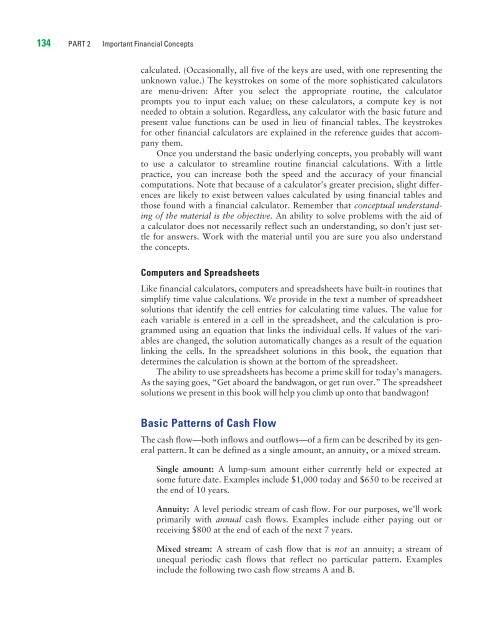Read the Chapter 4 E-Book
Read the Chapter 4 E-Book
Read the Chapter 4 E-Book
You also want an ePaper? Increase the reach of your titles
YUMPU automatically turns print PDFs into web optimized ePapers that Google loves.
134 PART 2 Important Financial Concepts<br />
calculated. (Occasionally, all five of <strong>the</strong> keys are used, with one representing <strong>the</strong><br />
unknown value.) The keystrokes on some of <strong>the</strong> more sophisticated calculators<br />
are menu-driven: After you select <strong>the</strong> appropriate routine, <strong>the</strong> calculator<br />
prompts you to input each value; on <strong>the</strong>se calculators, a compute key is not<br />
needed to obtain a solution. Regardless, any calculator with <strong>the</strong> basic future and<br />
present value functions can be used in lieu of financial tables. The keystrokes<br />
for o<strong>the</strong>r financial calculators are explained in <strong>the</strong> reference guides that accompany<br />
<strong>the</strong>m.<br />
Once you understand <strong>the</strong> basic underlying concepts, you probably will want<br />
to use a calculator to streamline routine financial calculations. With a little<br />
practice, you can increase both <strong>the</strong> speed and <strong>the</strong> accuracy of your financial<br />
computations. Note that because of a calculator’s greater precision, slight differences<br />
are likely to exist between values calculated by using financial tables and<br />
those found with a financial calculator. Remember that conceptual understanding<br />
of <strong>the</strong> material is <strong>the</strong> objective. An ability to solve problems with <strong>the</strong> aid of<br />
a calculator does not necessarily reflect such an understanding, so don’t just settle<br />
for answers. Work with <strong>the</strong> material until you are sure you also understand<br />
<strong>the</strong> concepts.<br />
Computers and Spreadsheets<br />
Like financial calculators, computers and spreadsheets have built-in routines that<br />
simplify time value calculations. We provide in <strong>the</strong> text a number of spreadsheet<br />
solutions that identify <strong>the</strong> cell entries for calculating time values. The value for<br />
each variable is entered in a cell in <strong>the</strong> spreadsheet, and <strong>the</strong> calculation is programmed<br />
using an equation that links <strong>the</strong> individual cells. If values of <strong>the</strong> variables<br />
are changed, <strong>the</strong> solution automatically changes as a result of <strong>the</strong> equation<br />
linking <strong>the</strong> cells. In <strong>the</strong> spreadsheet solutions in this book, <strong>the</strong> equation that<br />
determines <strong>the</strong> calculation is shown at <strong>the</strong> bottom of <strong>the</strong> spreadsheet.<br />
The ability to use spreadsheets has become a prime skill for today’s managers.<br />
As <strong>the</strong> saying goes, “Get aboard <strong>the</strong> bandwagon, or get run over.” The spreadsheet<br />
solutions we present in this book will help you climb up onto that bandwagon!<br />
Basic Patterns of Cash Flow<br />
The cash flow—both inflows and outflows—of a firm can be described by its general<br />
pattern. It can be defined as a single amount, an annuity, or a mixed stream.<br />
Single amount: A lump-sum amount ei<strong>the</strong>r currently held or expected at<br />
some future date. Examples include $1,000 today and $650 to be received at<br />
<strong>the</strong> end of 10 years.<br />
Annuity: A level periodic stream of cash flow. For our purposes, we’ll work<br />
primarily with annual cash flows. Examples include ei<strong>the</strong>r paying out or<br />
receiving $800 at <strong>the</strong> end of each of <strong>the</strong> next 7 years.<br />
Mixed stream: A stream of cash flow that is not an annuity; a stream of<br />
unequal periodic cash flows that reflect no particular pattern. Examples<br />
include <strong>the</strong> following two cash flow streams A and B.

















